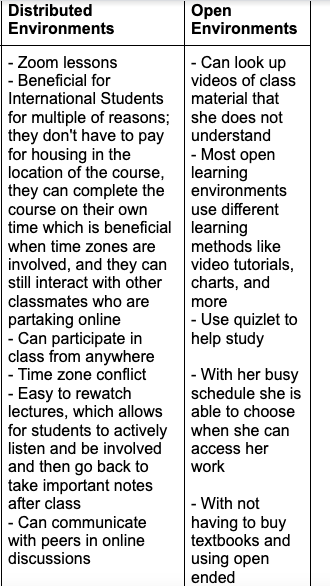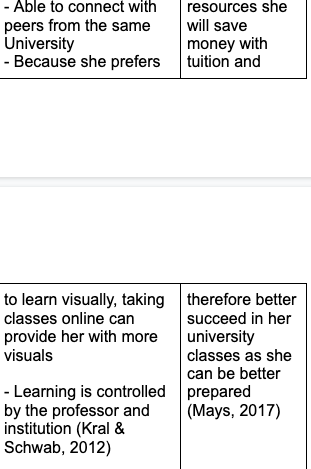Critically reflect on and articulate concepts around modality, pedagogy, and access, including distributed and open learning theory, online and open learning history, privacy laws, online learning communities, open research, and open data.
In my first blog post, I talked a lot about open learning communities in an elementary setting. I think learning communities, for example, our pods in this class allow for further learning to happen rather than just hearing from the professor or reading from a textbook.
My pod and I had some great discussion over how we feel about privacy laws on the platforms we are using:



Thanks to each of my pod members’ posts as well as the readings and Ryan’s posts I now have a greater understanding of the difference between distributed learning and open learning. In my blog, in week 2 I dissect a platform called “Skillshare” and I decide whether it is distributed or open.
Ryan commented on my blog post to let me know that there is a lot of debate about whether something is open or distributed.

The post that I really nailed the difference between the 2 was Ryan’s topic 3 post:

From completing these activities I learned that online and blended learning is extremely beneficial for students as they are able to learn remotely, rewatch or reread lessons, and much more. I have attached part of our chart from my pod project to show you the benefits of distributed and open online learning:


I also learned more about the concept of open pedagogy. I had heard the term before and had an idea of what I thought it was about but after week 3’s readings and blog posts I have much more of an understanding and why professionals would want to follow an open pedagogy. Having an open pedagogy means things are always changing as new things emerge. An open pedagogy means open education.
Emily, one of my pod members explained her sense of open pedagogy and did a great job at explaining it:
To begin the discussion on access and equity, I will be focussing on the first article by Mays (2017). Mays (2017) asks “what exactly does it mean to engage in “Open Pedagogy?”. From my understanding, open pedagogy connects the theories of open education to open educational resources (OER’s). It is the praxis that educators partake in to commit to a learner-driven education. This was a lightbulb to me, because the course we are in, and the others I have taken this summer, have all been learner-driven. The use of OER’s have allowed us to learn remotely and take our learning into our own hands. Personally, I think that this type of open and online learning best suits my own needs. I am able to work at my own pace, and discover my own learnings through light instructor guidance. Not only that, but most, if not all, of the OER’s that I have used in this course and my other summer courses have been free!
Emily Trelford, 2021
Rianne also talked about the concept of open pedagogy in her blog post. She even included a personal example:
In many of my class, research paper topics were optional. This could lead to many different ideas and thoughts. I was able to research the topic and find outside sources to support my argument. This is an example of Open Pedagogy. In other words, Open Pedagogy is when students engage in open education. This is to allow for students to be the center of their own learning and “democratizing vision for the educational process” (Mays, 2017, p. 10).
Rianne Yuen, 2021
I learned more about privacy in a digital setting. We need to be careful of who we are giving out information to. Do we assume that our information is kept private? I was shocked to find out in week 3’s reading that schools were tracking information and could see what students google and block certain words if on the school computer. Brightspace can also track how many times we log in and what we click on etc. It is unsettling.
OER’s have been around for a long time and open education has been a long time coming.
I also learned that online courses can look different depending on the professor. There are many different ways of presenting online courses. For example, in week 2’s reading they inserted a chart to show the differences:

All this new information is important to me as a future educator because I want to keep my future students safe and make sure a lack of privacy is never a concern. I also think online and blended learning would be something I could incorporate into my own classroom if I ended up teaching older grades. I also would be interested in taking another online or hybrid class.
References:
Gilliard, C., & Culik, H. (2016, May 24). Digital Redlining, Access, and Privacy. Common Sense Education.
Major, C. H. (2015). Teaching Online – A Guide to Theory, Research, and Practice. Retrieved from http://ebookcentral.proquest.com/lib/uvic/detail.action?docID=3318874 (pp. 76-108)
Mays, E. (Ed.). (2017). A guide to making open textbooks with students. Rebus Community.